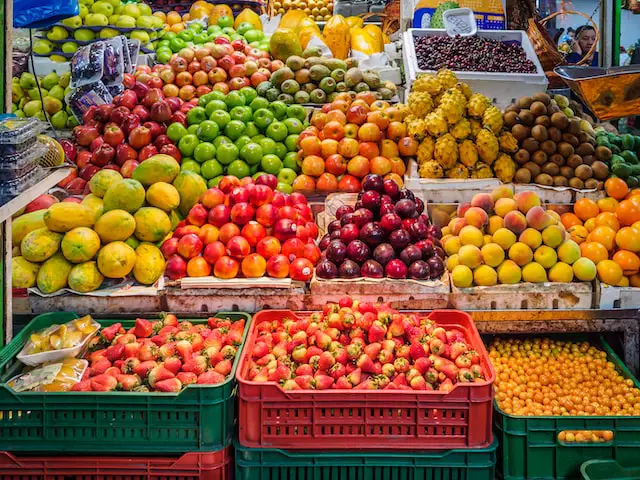Fruits are an essential part of our daily diet, providing us with essential vitamins and minerals. However, some fruits are more expensive than others. In this article, we will be taking a look at the 10 most expensive fruits in the world. These fruits are not only rare and difficult to find, but they also come with a high price tag. From the elusive and exotic durian to the rare and delicious Yubari King melons, these fruits are sure to leave your taste buds tantalized and your wallet empty. So, without further ado, let’s dive into the list of the 10 most expensive fruits in the world.
| No | Most Expensive Fruit | Price |
| 1 | Yubari King Melon | $45,000/Pair |
| 2 | Ruby Roman Grapes | $12,000/Bunch |
| 3 | Densuke Watermelon | $6,100 /Each |
| 4 | Taiyo no Tamago Mango | $4,000/Pair |
| 5 | Lost Gardens of Heligan Pineapple |
$1,600 /Each
|
| 6 | Square Watermelon |
$860 /Each
|
| 7 | Sembikiya Queen Strawberries | $85 /Pack |
| 8 | Dekopon Citrus | $80 /Pack |
| 9 | Sekai Ichi Apple | $20 /Each |
| 10 | Buddha Shaped Pears | $10 /Each |
Yubari King Melon
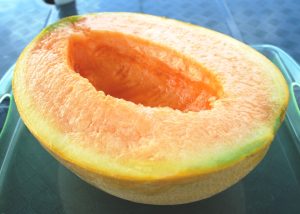
The Yubari King Melon is the most expensive fruit in the world. The Yubari King Melon is a type of cantaloupe that is grown in the Yubari region of Japan. It is known for its sweet and juicy flesh and is considered to be one of the most expensive fruits in the world. The melons are grown under strict conditions, including being hand-pollinated and hand-harvested. They are also carefully selected and graded based on their shape, size, and color. The Yubari King Melon is often given as a luxury gift or used in high-end desserts.
Ruby Roman Grapes
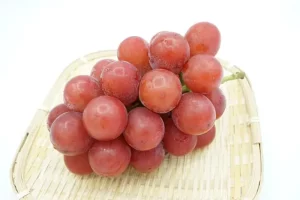
Ruby Roman Grapes are the 2nd most expensive fruit in the world. Ruby Roman grapes are a type of seedless grape variety that is known for its deep red color and sweet taste. They are typically larger than other grape varieties and have a firm texture. They are often used for table grapes, juicing, and winemaking. These grapes are typically harvested in late summer or early fall.
Densuke Watermelon
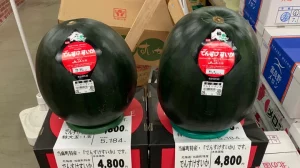
Densuke Watermelon is the 3rd most expensive fruit in the world. Densuke watermelon is a type of watermelon that is grown in Japan and is known for its unique black rind and sweet, juicy flesh. It is considered a delicacy and is considered one of the most expensive fruits in the world, with prices reaching as high as $6,100 for a single melon. The watermelon is grown on the northern island of Hokkaido and is known for its high sugar content and crisp texture. It is typically harvested in June and July and is sold in limited quantities.
Taiyo no Tamago Mango
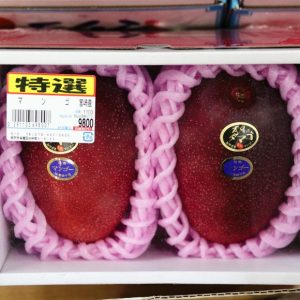
Taiyo no Tamago Mango is the 4th most expensive fruit in the world. The Taiyo no Tamago Mango is a type of mango that is grown in Japan. It is known for its sweet and juicy flesh, and its bright orange color. The fruit is typically large and has a smooth and slightly curved shape. It has a thin skin that is easy to peel, and the flesh is soft and fragrant. The Taiyo no Tamago Mango is a popular choice for eating fresh, as well as for use in cooking and baking.
Lost Gardens of Heligan Pineapple

Lost Gardens of Heligan Pineapple is the 5th most expensive fruit in the world. The fruit of the Lost Gardens of Heligan Pineapple is a traditional pineapple, also known as Ananas comosus. It is a tropical fruit with sweet and juicy flesh, surrounded by tough and spiky outer skin. The pineapple is usually consumed fresh, but can also be used in cooking and canning. It is a good source of vitamin C and other nutrients.
Square Watermelon
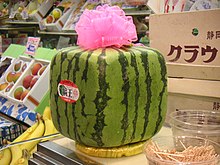
Square Watermelon is the 6th most expensive fruit in the world. Square watermelon is a unique type of watermelon that is grown square, rather than the traditional round shape. This is achieved by growing the watermelon in a square container, which shapes the fruit as it grows. Square watermelons are typically smaller in size than traditional watermelons and are considered a novelty item. They are often used for decorative purposes and are not commonly found in grocery stores. Square watermelons are primarily grown in Japan and are considered a luxury item, due to the high cost of production.
Sembikiya Queen Strawberries

Sembikiya Queen Strawberries are the 7th most expensive fruit in the world. Sembikiya Queen Strawberries are a variety of strawberry that is known for their large size and sweet taste. These strawberries are grown in Japan and are considered a delicacy. They are often sold at a premium price due to their high quality and limited availability. They are typically harvested in late spring and early summer and are enjoyed fresh or used in desserts and jams.
Dekopon Citrus
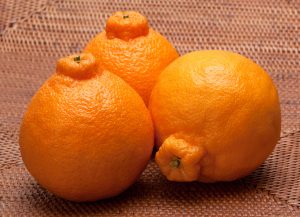
Dekopon Citrus is the 8th most expensive fruit in the world. Dekopon Citrus, also known as Sumo Citrus, is a hybrid citrus fruit that is a cross between a mandarin orange and a ponkan. It is known for its large size, sweet taste, and minimal seeds. It is typically grown in Japan and California and is available in late winter and early spring. It is considered a premium fruit and is often more expensive than other citrus fruits.
Sekai Ichi Apple
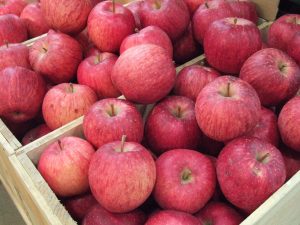
Sekai Ichi Apple is the 9th most expensive fruit in the world. The fruit of Sekai Ichi Apple (meaning “world’s best apple” in Japanese) is a type of apple that is known for its sweet and juicy flavor, crisp texture, and high sugar content. It is typically a medium to large-sized apple with a red and green coloration. It is often used for eating fresh, as well as for cooking and baking.
Buddha Shaped Pears
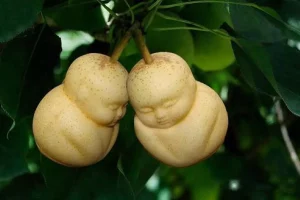
Buddha Shaped Pears is the 10th most expensive fruit in the world. Buddha-shaped pears are a type of fruit that is grown to have a shape that resembles the Buddha. These pears are grown in China and are considered a delicacy. They are grown using a technique called “grafting,” in which a pear tree is grafted onto a rootstock in the shape of the Buddha. The pears are then carefully pruned and trained to grow in the desired shape. These pears are not only consumed as fresh fruit but also used as gifts or decorations.
Frequently Asked Questions
What is a luxury fruit?
A luxury fruit is a type of fruit that is considered high-end or exclusive, typically due to its rarity, high cost, or unique flavor and texture. Examples of luxury fruits include:
- Durian: A large, spiky fruit native to Southeast Asia that is known for its strong, pungent odor and creamy, rich flavor. It is considered a delicacy in many Asian cultures.
- Black truffles: A type of edible fungus that is highly sought after for its unique, earthy flavor and aroma. They are typically found in the wild and can be expensive to purchase.
- Yubari King Melons: A type of cantaloupe grown in the Yubari region of Japan. They are known for their sweet, juicy flesh and are considered a luxury item due to their high cost.
- Mangosteen: A tropical fruit native to Southeast Asia that is known for its sweet, tangy flavor and juicy white flesh. It is considered a delicacy due to its short growing season and difficulty in cultivating.
- Persimmon: A type of fruit that is native to Japan, China, and Korea. It is typically considered a luxury fruit due to its unique flavor and texture, as well as its high cost.
How to get rid of fruit flies?
- Clean thoroughly: Fruit flies are attracted to dirty surfaces, so make sure you clean your kitchen and bathroom thoroughly, including the sink and garbage disposal.
- Seal off food: Keep all food, including fruits and vegetables, in sealed containers or the refrigerator to prevent fruit flies from accessing it.
- Use vinegar traps: Fill a small container with apple cider vinegar and a drop of dish soap. Cover the top with plastic wrap and poke small holes in it. The fruit flies will be attracted to the vinegar and will get trapped in the container.
- Use essential oils: Some essential oils, such as peppermint, clove, and lemongrass, can repel fruit flies. Simply add a few drops to a diffuser or spray bottle and mist the area where the fruit flies are present.
- Call a professional exterminator: If the infestation is severe, it may be necessary to call in a professional exterminator to eliminate the problem.
- Keep trash sealed: Make sure your garbage bags are sealed tightly and dispose of them frequently.
- Keep your drains clean: Fruit flies often breed in dirty drains, so keep them clean by pouring hot water and vinegar down them regularly.
- Keep the windows and doors closed: To prevent fruit flies from flying in, make sure your windows and doors are closed as much as possible.
How to eat dragon fruit?
- Cut the dragon fruit in half with a sharp knife.
- Scoop out the flesh with a spoon, being careful not to scoop out the seeds.
- Cut the flesh into small cubes or slices.
- Enjoy the dragon fruit on its own or add it to a fruit salad, smoothie, or yogurt.
- If you prefer, you can also remove the skin and eat the flesh directly.
- Some people also like to eat dragon fruit with a sprinkle of chili powder or lime juice for added flavor. Experiment to find your favorite way to enjoy it.
How to cut a dragon fruit?
- Rinse the dragon fruit under cool water and pat dry with a towel.
- Cut off the top and bottom of the dragon fruit with a sharp knife.
- Cut the dragon fruit in half lengthwise, slicing through the center of the fruit.
- Use a spoon to scoop out the flesh from the skin. You can also use a knife to make thin slices of the flesh.
- Discard the skin and cut the flesh into desired pieces.
- Enjoy the dragon fruit as a healthy snack or add it to your favorite smoothie or salad.
Where do fruit flies come from?
Fruit flies typically come from overripe or rotting fruits and vegetables that are left out in the open, as well as from drains, garbage disposals, and other areas where the organic matter may accumulate. They can also come from compost piles and other areas where organic matter is decomposing. In some cases, fruit flies can also come from commercial fruit that is already infested with insects.
What does dragon fruit taste like?
Dragon fruit has a unique taste that is often described as a combination of sweet and tart. It has a subtle sweetness with a slightly tangy flavor, similar to a kiwi or a pear. The texture is also unique, with slightly crunchy skin and soft, juicy flesh that is studded with small black seeds. Some people also describe dragon fruit as having a slightly floral or melon-like taste. Overall, dragon fruit has a refreshing and distinct flavor that is enjoyed by many.
What is a date fruit?
Date fruit is a sweet, edible fruit that grows on the date palm tree. The fruit is typically oval or cylindrical and can range in color from yellow to red to black. Dates are a staple food in many Middle Eastern and North African countries and are often eaten dried, fresh, or used in cooking and baking. They are a rich source of vitamins and minerals, including potassium, magnesium, and vitamin K.
How to eat star fruit?
- Rinse the star fruit under cold water to remove any dirt or debris.
- Slice off the ends of the fruit with a sharp knife.
- Cut the star fruit into thin slices, about 1/4 inch thick.
- Remove any seeds that may be present in the fruit slices.
- Enjoy the star fruit as is or add it to a fruit salad or smoothie.
- If you prefer, you can also squeeze a little lemon or lime juice on top to enhance the flavor.
- Starfruit can also be grilled or used in savory dishes as a garnish or ingredient.
- Be sure to discard any spoiled or discolored sections of the fruit before eating.
What is monk fruit?
Monk fruit, also known as luo han guo, is a small round fruit native to Southeast Asia. It has been used for centuries in traditional Chinese medicine for its medicinal properties. The fruit is known for its extremely sweet taste, which is due to the presence of a compound called mogroside. This compound is up to 300 times sweeter than sugar, making it a popular alternative sweetener for those looking to reduce their sugar intake. The fruit is also high in antioxidants and has been shown to have anti-inflammatory and anti-cancer properties. It is commonly used in supplements, teas, and food and beverage products as a natural sweetener.
How long do fruit flies live?
The lifespan of a fruit fly ranges from 7 to 45 days, depending on the conditions and the species. The average lifespan is around 30 days.
How to make a smoothie with frozen fruit?
- Gather ingredients: You will need frozen fruit of your choice (such as berries, mango, or peaches), a liquid base (such as milk, yogurt, or juice), and any additional ingredients you want to add (such as honey, spinach, or protein powder).
- Blend the frozen fruit: Place the frozen fruit in a blender and pulse until it is broken up and starting to blend.
- Add the liquid base: Slowly pour in your liquid base while blending the frozen fruit. This will help to smooth out the consistency of the smoothie.
- Add additional ingredients: If you want to add any additional ingredients, such as honey or spinach, add them now and blend until smooth.
- Taste and adjust: Taste the smoothie and adjust the sweetness or consistency as needed. If it is too thick, add more liquid. If it is too sweet, add a squeeze of lemon juice.
- Serve and enjoy: Pour the smoothie into a glass and enjoy immediately. You can also pour the smoothie into a lidded container and store it in the freezer for a future treat.
What is dragon fruit?
Dragon fruit, also known as pitaya or pitahaya, is a tropical fruit that grows on cactus plants. It is native to Central and South America but is now also grown in Southeast Asia and other parts of the world. The fruit has bright pink or yellow skin, and the flesh is white or pink with small black seeds. It has a sweet and slightly sour taste and is often eaten fresh or used in smoothies, desserts, and salads. The fruit is also believed to have various health benefits, such as being high in antioxidants and helping to lower cholesterol levels.
How to eat passion fruit?
- Cut the passion fruit in half with a sharp knife.
- Use a spoon to scoop out the edible seeds and pulp.
- Eat the seeds and pulp directly or add them to a smoothie, yogurt, or ice cream.
- Alternatively, you can squeeze the juice out of the passion fruit and drink it as is or use it as a topping or ingredient in recipes.
- Discard the skin and any inedible parts.
- Enjoy the delicious, tangy flavor of passion fruit!
What fruit can dogs eat?
Dogs can eat a variety of fruits such as apples, blueberries, strawberries, bananas, watermelon (seedless), and cantaloupe (seedless). It is important to cut the fruit into small, bite-size pieces and remove any seeds or pits as they can be harmful to dogs. Additionally, some fruits like grapes and raisins can be toxic to dogs, so they should not be fed. It is always best to consult with a veterinarian before introducing new foods to your dog’s diet.
What’s the rarest fruit in the world?
The rarest fruit in the world is considered to be the miracle fruit (Synsepalum dulcificum), also known as the “miracle berry.” This fruit, native to West Africa, contains a protein called miraculin that temporarily alters the taste receptors on the tongue, making sour and acidic foods taste sweet. Due to its rarity and unique properties, it is considered a rare delicacy and is highly sought after by chefs and food enthusiasts.

